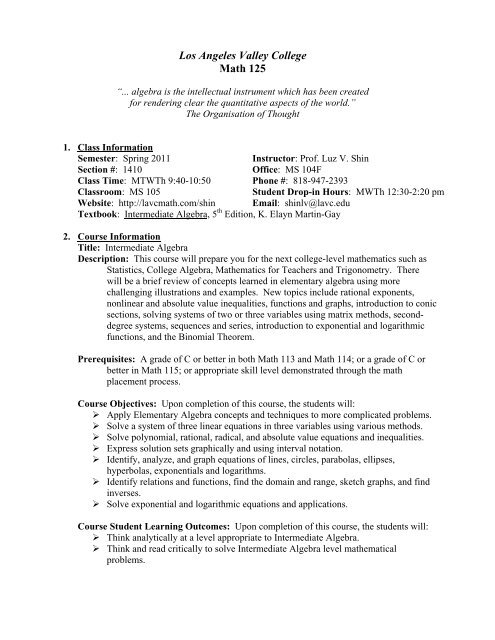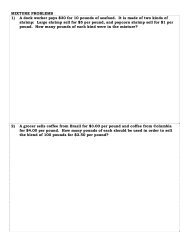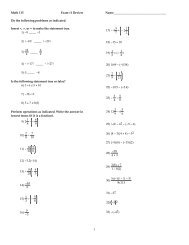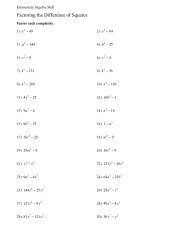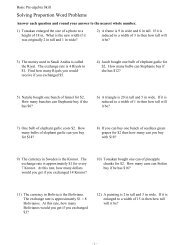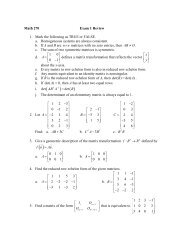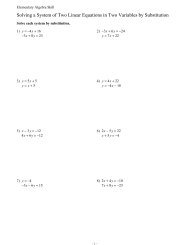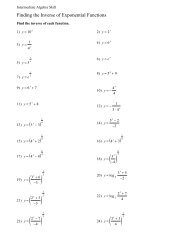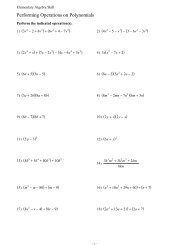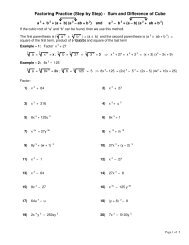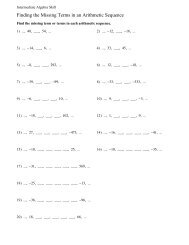Syllabus - LAVC Math Department
Syllabus - LAVC Math Department
Syllabus - LAVC Math Department
You also want an ePaper? Increase the reach of your titles
YUMPU automatically turns print PDFs into web optimized ePapers that Google loves.
Los Angeles Valley College<strong>Math</strong> 125“... algebra is the intellectual instrument which has been createdfor rendering clear the quantitative aspects of the world.”The Organisation of Thought1. Class InformationSemester: Spring 2011Instructor: Prof. Luz V. ShinSection #: 1410Office: MS 104FClass Time: MTWTh 9:40-10:50 Phone #: 818-947-2393Classroom: MS 105Student Drop-in Hours: MWTh 12:30-2:20 pmWebsite: http://lavcmath.com/shin Email: shinlv@lavc.eduTextbook: Intermediate Algebra, 5 th Edition, K. Elayn Martin-Gay2. Course InformationTitle: Intermediate AlgebraDescription: This course will prepare you for the next college-level mathematics such asStatistics, College Algebra, <strong>Math</strong>ematics for Teachers and Trigonometry. Therewill be a brief review of concepts learned in elementary algebra using morechallenging illustrations and examples. New topics include rational exponents,nonlinear and absolute value inequalities, functions and graphs, introduction to conicsections, solving systems of two or three variables using matrix methods, seconddegreesystems, sequences and series, introduction to exponential and logarithmicfunctions, and the Binomial Theorem.Prerequisites: A grade of C or better in both <strong>Math</strong> 113 and <strong>Math</strong> 114; or a grade of C orbetter in <strong>Math</strong> 115; or appropriate skill level demonstrated through the mathplacement process.Course Objectives: Upon completion of this course, the students will:‣ Apply Elementary Algebra concepts and techniques to more complicated problems.‣ Solve a system of three linear equations in three variables using various methods.‣ Solve polynomial, rational, radical, and absolute value equations and inequalities.‣ Express solution sets graphically and using interval notation.‣ Identify, analyze, and graph equations of lines, circles, parabolas, ellipses,hyperbolas, exponentials and logarithms.‣ Identify relations and functions, find the domain and range, sketch graphs, and findinverses.‣ Solve exponential and logarithmic equations and applications.Course Student Learning Outcomes: Upon completion of this course, the students will:‣ Think analytically at a level appropriate to Intermediate Algebra.‣ Think and read critically to solve Intermediate Algebra level mathematicalproblems.
3. Course RequirementsSchool Supplies: The student is expected to bring the following to each class session:‣ Textbook‣ Notebook (3-ring binder or file folder) for notes and homework‣ Pens, pencils and erasers‣ Six Testing booklets (bluebooks/greenbooks) for examsHomework and Group Work: Refer to the timeline provided for the semester.Homework is required and done online using My<strong>Math</strong>Lab (handout will be provided).Homework should be done daily to keep up with the class. Group Work will be given daily.<strong>Math</strong>ematics is not a spectator sport, so you have to do the work!Long Exams: There will be five Long Exams; each will be out of 100 points. Each examis free response and covers one or two chapters. Students are not allowed to use notesduring exams, but calculators are permitted. The tentative testing schedule is given in thetimeline.Final Exam: Finals is a two-hour comprehensive free response exam and is out of 100points.4. Class PolicyAttendance: REGULAR ATTENDANCE is very much encouraged! School policy onattendance is enforced. The instructor may exclude students who have excessive absences.There will be sign-in sheets that will be passed around each meeting. It is the student’sresponsibility to make sure that he/she signs in for his/her attendance.Withdrawals: If you stop attending the class (or wish to drop a class), you must drop theclass yourself – officially – over the internet or in person at the Office of Admissions andRecords. Failure to do so may result in a grade of “F” in the class. Please take note ofimportant dates noted in the timeline.SSD Students: To make arrangements for special accommodations that have beenrecommended by SSD for students with disabilities, please contact the instructor.Cell Phones and Text Messaging: Please turn off or silent (not vibrate) all phones beforecoming to class. No text messaging, no MP3’s, no ipods, and no hand-held video gameswhile class is in session. Class time is for learning mathematics, not for personalcommunication or entertainment.Cheating: Any form of academic dishonesty will not be tolerated. If caught, you may begiven a zero for that particular exam.Student Conduct: Students are expected to adhere to all district policies as described inthe <strong>LAVC</strong> Spring 2011 Schedule of Classes including attendance (p. 145-146) andwithdrawal from classes (p.151), and Standards of Student Conduct (p. 154-156).
5. Grading SystemEvaluation: The total points earned will be computed out of a grand total of 700 points.No make-up exam will be given at any circumstance! If you miss an exam, a grade will beassigned from your final exam performance on the missed exam’s coverage.‣ Homework and Group Work‣ Long Exams‣ Final Exam100 points500 points100 pointsGrading Curve:‣ A 90 – 100 630 – 700 points‣ B 80 – 89 560 – 629 points‣ C 70 – 79 490 – 559 points‣ D 55 – 69 385 – 489 points‣ F below 55 below 385 points6. Tips for Success in this class‣ Choose to attend all class periods on time and don’t leave early.‣ Pay attention in class, participate in class discussions, and ask questions. Theinstructor regularly gives away tips for exams and quizzes, so make sure you takenote of them.‣ Do or attempt all homework not for the sake of just doing it, but trying to understandthe concepts, learning them in the process. “Practice makes perfect” applies notonly to music and sports, but also in mathematics. Be sure to schedule sufficienttime to complete your assigned tasks before the next class period.‣ Know how to get help if you need it.• Attend scheduled review sessions (workshops).• Consult instructor during posted student drop-in hours.• Drop by the <strong>Math</strong> Lab (MS 106) for tutoring services.‣ Organize your class materials, including homework assignments, graded quizzes andtests, notes and worked out review problems. These items will make valuablereferences when studying for upcoming tests and the final exam."<strong>Math</strong>ematics is a more powerful instrument of knowledgethan any other that has been bequeathed to us by human agency."-- Descartes


